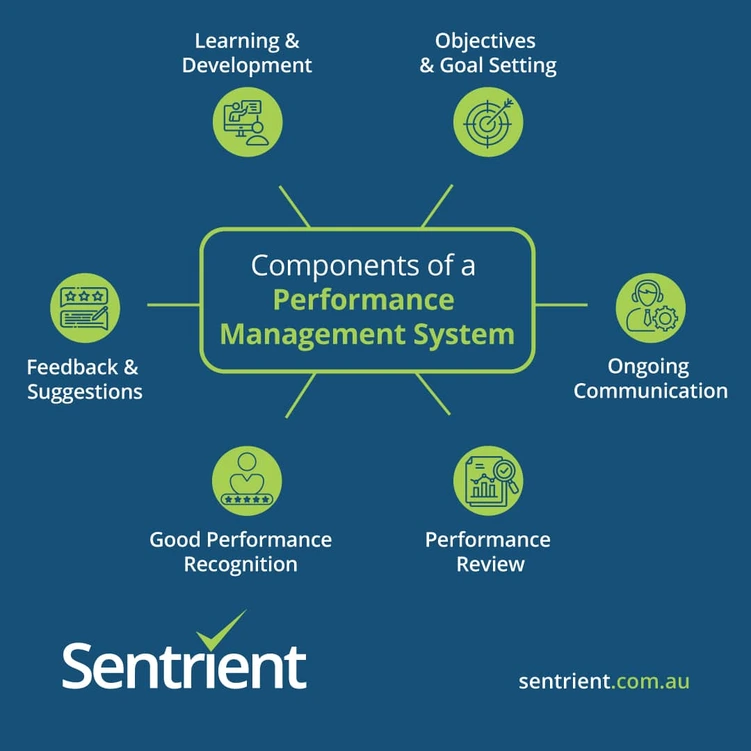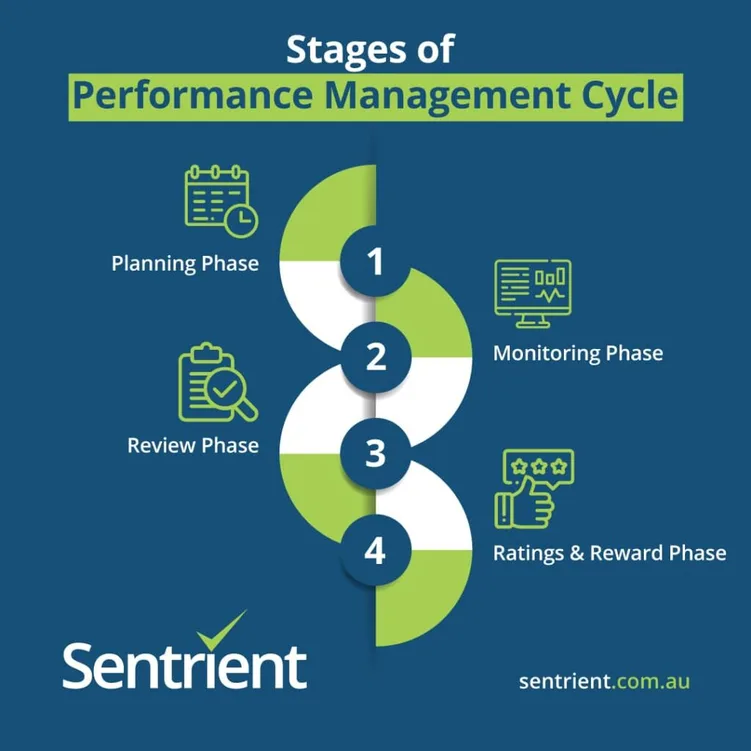Nowadays, managing employee performance effectively can significantly affect your organisation’s success.
Whether leading a small startup or overseeing a large enterprise, you need a systematic approach to tracking, evaluating, and improving employee performance.
This is where a performance management system comes into play.
Gone are the days of annual reviews and rigid evaluation forms. Modern performance management has evolved into a dynamic, continuous process focusing on employee development, real-time feedback, and achieving organisational goals.
As businesses increasingly adopt remote and hybrid work models, having a robust performance management system has become more crucial than ever.
In this comprehensive guide, you’ll discover everything you need to know about performance management systems.
What is a Performance Management System?
A performance management system is a structured framework that helps you track, evaluate, and enhance employee performance throughout their journey with your organisation.
Unlike traditional annual reviews, a modern performance management system is an ongoing process that connects various aspects of employee development. It’s not just about evaluating what your employees have done; it’s about setting clear expectations, providing regular feedback, and creating opportunities for growth and improvement.
At its core, a performance management system helps you align individual employee goals with your broader organisational objectives.
For example, if your company aims to increase customer satisfaction by 20%, your system should help break this down into specific, measurable targets for customer service representatives, like maintaining a 95% positive feedback rating or reducing response times to under two hours etc.
These systems typically combine both digital tools and human processes. The digital aspect might include software for goal tracking, performance reviews, and feedback collection, while the human element involves regular check-ins, coaching sessions, and development planning.
Together, they create a comprehensive approach to managing and improving employee performance.
Why is a Performance Management System Important?
A performance management system is crucial for your organisation’s success. Here’s why implementing one can transform your workplace.
First, it helps you maintain precise alignment between individual employee goals and your organisation’s broader objectives.
When your team members understand how their work contributes to the company’s success, they’re more likely to stay motivated and engaged. This alignment ensures everyone is rowing in the same direction, making your organisation more efficient and effective.
These systems also provide valuable data-driven insights into your workforce’s performance.
You can identify top performers, spot emerging talent, and address performance issues before they become serious problems. This data helps you make informed decisions about promotions, training needs, and resource allocation.
A well-implemented performance management system creates transparency and fairness for your employees. They know exactly what’s expected of them and how their performance will be measured.
This clarity reduces workplace stress and increases job satisfaction. Regular feedback and development opportunities help them grow professionally and advance their careers within your organisation.
From a business perspective, these systems help improve productivity and reduce costs. You can identify inefficiencies in processes and workflows by consistently tracking performance metrics.
Regular performance discussions help prevent expensive turnover by addressing employee concerns early and keeping them engaged.
Perhaps most importantly, a performance management system helps create a culture of continuous improvement.
Rather than treating performance reviews as annual events to be dreaded, it transforms them into ongoing conversations about growth and development. This shift in perspective can dramatically improve workplace morale and productivity.
Evolution of a Performance Management System
Performance management systems have undergone significant transformation over the decades, evolving from simple annual reviews to sophisticated digital platforms.
Here’s how these systems have evolved:
Traditional Era (1940s-1980s):
You would have seen basic annual performance reviews focusing solely on past performance. The process was typically top-down, with managers providing one-way feedback through standardised forms.
These systems were primarily used for determining raises and promotions, with little emphasis on employee development.
Transition Period (1980s-2000s):
During this time, organisations began recognising the limitations of annual reviews. You’d notice the introduction of more frequent check-ins and the emergence of 360-degree feedback systems.
The focus started shifting from pure evaluation to including development planning.
Digital Revolution (2000s-2010s):
With technology advancement, we gained access to the first digital performance management tools. These systems were introduced:
- Automated review processes
- Digital goal tracking
- Online feedback submission
- Performance data analytics
Modern Era (2010s-Present):
Today’s systems reflect a complete transformation in how you manage performance:
- Real-time feedback capabilities
- Mobile-first platforms
- AI-powered insights
- Integration with learning management systems
- Continuous performance tracking
- Remote work compatibility
This evolution reflects a fundamental shift in how organisations view performance management – from a purely evaluative tool to a comprehensive system supporting employee growth and organisational success.
Components of a Performance Management System
A robust performance management system comprises several interconnected components that create a comprehensive framework for employee development and organisational success.

Objectives & Goal Setting
Within your performance management system, establishing clear objectives is crucial for success.
You must implement SMART goals that align individual performance with organisational objectives.
This process involves carefully defining expectations, creating measurable targets, and establishing realistic timelines. The performance management process should ensure that goals are regularly reviewed and adjusted based on changing business needs.
Your goal-setting framework should include both short-term milestones and long-term development objectives. This will help employees understand their immediate priorities while considering their career progression.
You can consider implementing quarterly goal reviews to maintain relevance and engagement.
Ongoing Communication
Effective communication forms the backbone of any successful type of performance management system.
Regular interactions should include weekly or bi-weekly check-ins, progress updates, and team meetings.
Many organisations now leverage performance management system software to facilitate these communications, making documenting discussions and tracking progress easier. Your communication strategy should encompass various channels, including face-to-face meetings, virtual check-ins, and digital platforms.
This multi-channel approach ensures that feedback and information flow smoothly, regardless of work arrangements. Remember to document key discussions and decisions to maintain accountability and track progress.
Performance Review
The evolution of performance reviews has transformed how organisations evaluate employee contributions.
While moving away from traditional annual reviews, your performance management system process should still include structured evaluations that help measure progress, identify improvement areas, and plan future development.
Modern review processes often incorporate continuous feedback mechanisms, skills assessments, and development planning. Therefore, you must consider implementing quarterly performance check-ins alongside comprehensive annual reviews.
These sessions should focus not just on past performance but also on future potential and development opportunities.
Good Performance Recognition
Creating a culture of recognition is essential for maintaining motivation and engagement.
Your performance management system should include various recognition methods, from monetary rewards to career advancement opportunities. You should implement a points-based recognition system, public acknowledgment platforms, and structured career progression paths.
In addition, recognition programs should be transparent, fair, and consistently applied across the organisation. While at it, include formal and informal recognition methods, from simple thank-you notes to structured bonus programs.
Celebrating big and small achievements helps maintain high team morale and encourages continued excellence.
Feedback & Suggestions
Modern performance management systems give you powerful tools for gathering and sharing feedback.
You’ll want to create multiple channels for open, honest communication. This might include anonymous suggestion boxes for sensitive topics, regular pulse surveys to gauge team morale and structured peer feedback sessions for specific projects.
You can consider implementing a 360-degree feedback process where employees receive input from managers, peers, and direct reports.
When doing so, you need to make sure that you’re not just collecting feedback but acting on it—share what you’ve heard and what changes you’re making in response.
You can train your team to effectively give and receive constructive feedback. This includes teaching them to be specific, focus on behaviours rather than personalities, and always include suggestions for improvement.
This is why regular feedback helps prevent minor issues from becoming big problems and creates opportunities for continuous improvement.
Learning & Development
To make your performance management truly effective, you must invest in your team’s growth and development.
You can start by identifying each person’s current skills and future goals. The next step is to create personalised development plans that might include formal training, mentorship opportunities, and on-the-job learning experiences.
You might set up a mentoring program where experienced team members can share their knowledge, or create project opportunities that stretch people’s abilities.
This might mean providing leadership training for potential managers, technical certifications for specialists, or communication workshops for customer-facing roles.
Stages of the Performance Management Cycle
Now, let’s understand the four key stages of the performance management cycle that make up an effective performance management system:

1. Planning Phase
In this first stage of your performance management process, you’ll work with each employee to set clear objectives for the upcoming period.
We recommend discussing your organisation’s goals and how its role contributes to these targets. You’ll create SMART goals, establish performance expectations, and identify the resources and support they’ll need.
You must consider short-term objectives (like quarterly targets) and long-term development goals (yearly).
During this phase, you might use your performance management system software to document goals, timelines, and success metrics.
2. Monitoring Phase
During this crucial stage, the performance management, you’ll track progress and provide ongoing support.
Please think of this as your regular check-in period, during which you observe performance, offer feedback, and address challenges before they become problems. You’ll want to maintain open communication through regular one-on-ones, team meetings, and informal catch-ups.
You can use your performance tracking tools to document achievements, challenges, and any goal adjustments.
This is also when you identify any additional training or resources your team members might need to succeed.
3. Review Phase
The review stage is where your performance management efforts come together for evaluation.
Unlike traditional annual reviews, modern review phases often happen quarterly or biannually.
During this time, you’ll assess progress toward goals, discuss successes and challenges, and gather feedback from various sources. Consider using 360-degree feedback tools to get a comprehensive view of performance.
Remember to focus on specific examples and measurable results while discussing the development of behavioural competencies and soft skills.
4. Ratings & Reward Phase
In this final stage of your performance management process, you’ll evaluate overall performance and determine appropriate recognition or rewards.
This might include performance ratings, salary adjustments, bonuses, promotions, or other forms of recognition. In this stage, the most important thing is to be transparent about how ratings are determined and how they relate to rewards.
You should use data collected throughout the cycle to make fair, objective decisions.
Remember, you must also discuss future development opportunities and set the stage for the next planning phase.
Each stage builds upon the previous one, creating a continuous cycle of improvement and development. The key is to maintain consistency and clear communication throughout each phase while using performance management tools to track and support progress.
Who Uses Performance Management Software?
Understanding who uses a performance management system helps you implement it effectively.
Let’s look at the key user groups.
Employees
As an employee, you’ll interact with your performance management system throughout your workday.
The system becomes your central hub for tracking progress toward goals, documenting achievements, and managing professional development. You can request colleague feedback, access your performance reviews, and monitor your training completion.
Most importantly, you’ll use the system to align with your objectives and communicate regularly with your manager about your progress and challenges.
HR Professionals
When you work in HR, the performance management system becomes your primary tool for orchestrating company-wide performance initiatives.
The performance management process helps you design and implement performance frameworks, track organisational goals, and generate valuable analytics. You’ll oversee review cycles, coordinate training programs, and ensure compliance with performance policies.
The system allows you to monitor employee engagement, identify training needs across departments, and develop succession planning strategies based on performance data.
Managers
As a manager, you’ll rely on types of performance management systems to effectively guide your team’s development and success.
The performance management system enables you to set and align team goals with organisational objectives while tracking individual performance metrics. You can schedule and document regular check-ins, provide timely feedback, and recognise team achievements.
The system helps you make data-driven decisions about resource allocation, development opportunities, and performance improvements.
You can monitor team progress through comprehensive reporting tools and ensure everyone stays on track toward their goals.
Performance Management Trends
Looking at the latest performance management trends, here’s what’s shaping the future of employee evaluation and development.
Continuous Performance Management
The traditional annual review gives way to ongoing feedback in modern performance management system frameworks.
You’ll find organisations implementing regular check-ins, real-time feedback tools, and continuous goal tracking.
Your performance management system software likely includes features for quick feedback sharing, instant recognition, and regular progress updates. This approach helps you promptly address issues, celebrate successes, and align your team with rapidly changing business needs.
Deskless and Field Workers
As remote and field work becomes more common, performance management systems adapt to support employees who aren’t at a desk.
Your performance management process must now accommodate workers in various locations and situations. This includes mobile-friendly performance tools, offline access capabilities, and simplified feedback mechanisms.
You might use location-based check-ins, mobile performance-tracking apps, and digital communication tools designed specifically for field workers.
Dynamic Teams
The modern performance management system process is evolving to support fluid team structures.
As project-based work increases, you need flexible systems to track performance across changing team compositions.
Your performance management approach might include:
- Cross-functional team evaluations
- Project-based performance metrics
- Adaptive goal setting
- Multi-manager feedback systems
- Collaborative performance tracking
- Agile performance reviews
These trends reflect the changing nature of work and the need for more flexible, responsive performance management approaches.
By staying ahead of these trends, you can ensure that your performance management system remains effective and relevant to your workforce.
Conclusion
As you’ve seen throughout this guide, implementing the right performance management system is crucial for your organisation’s success.
The evolution from annual reviews to continuous feedback shows how performance management continues to adapt to modern workplace needs.
To take your performance management to the next level, consider Sentrient’s comprehensive performance management system software.
The performance management process doesn’t have to be complicated.
Sentrient’s performance management system gives you a user-friendly solution that grows with your organisation. Our performance management systems adapt to your unique needs while maintaining best practices in employee development and performance tracking.
Performance management systems FAQs:
1) How often should I conduct performance reviews?
While using your performance management system, aim for quarterly formal reviews supplemented with weekly or bi-weekly check-ins. This balanced approach helps you address issues promptly while maintaining structured evaluation periods.
2) What’s the difference between performance management and performance appraisal?
Performance appraisal is just one part of your overall performance management process. While appraisals focus on evaluating past performance, your performance management system includes goal setting, ongoing feedback, development planning, and continuous improvement.
3) How do I measure the success of my performance management system?
In your performance management system, you can track key metrics like employee engagement scores, goal completion rates, turnover rates, and productivity metrics. In addition, you can monitor feedback, participation rates, and employee satisfaction with the review process.
4) Can performance management work for remote teams?
Yes! Modern performance management systems are designed for both in-office and remote teams. You can use digital tools for regular check-ins, video conferences for reviews, and online platforms for goal tracking and feedback.
5) How do I handle poor performance within my performance management system?
Your performance management approach should include clear procedures for addressing performance issues. You can start with frequent feedback, document concerns, create specific improvement plans with measurable goals, and provide necessary support and resources. You can even consider using your system to track progress and maintain detailed records of all discussions and actions.





